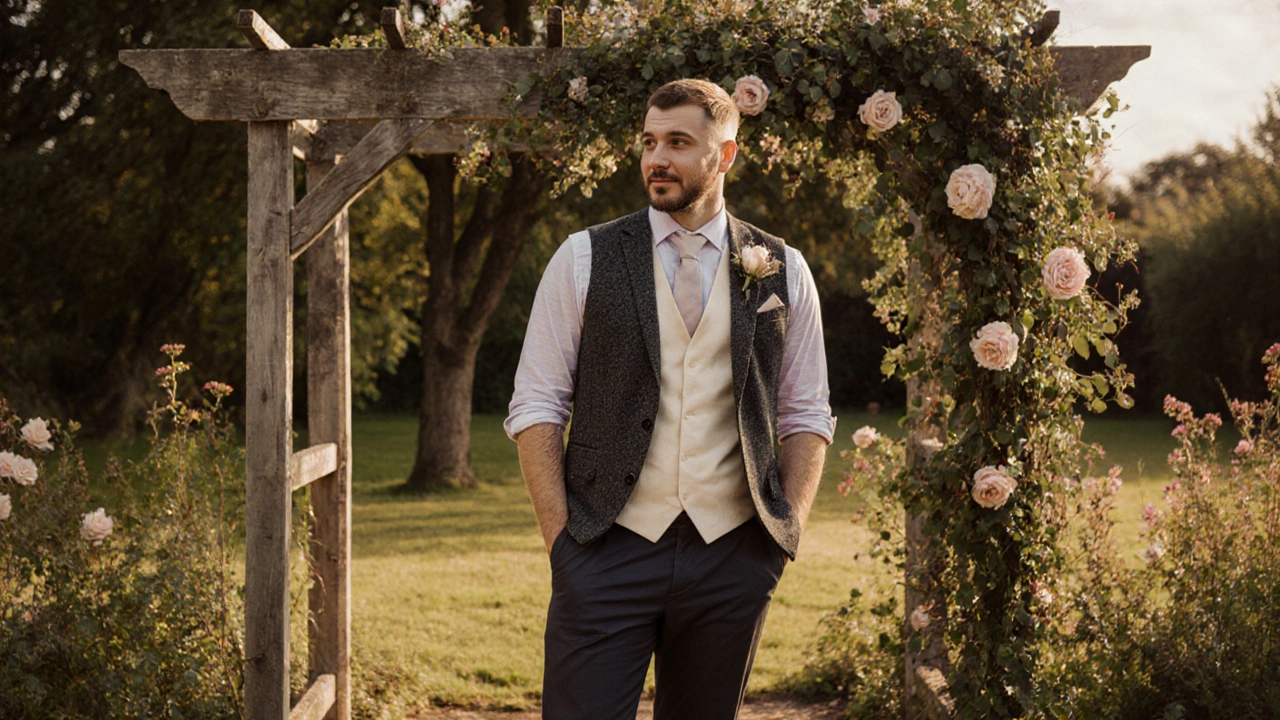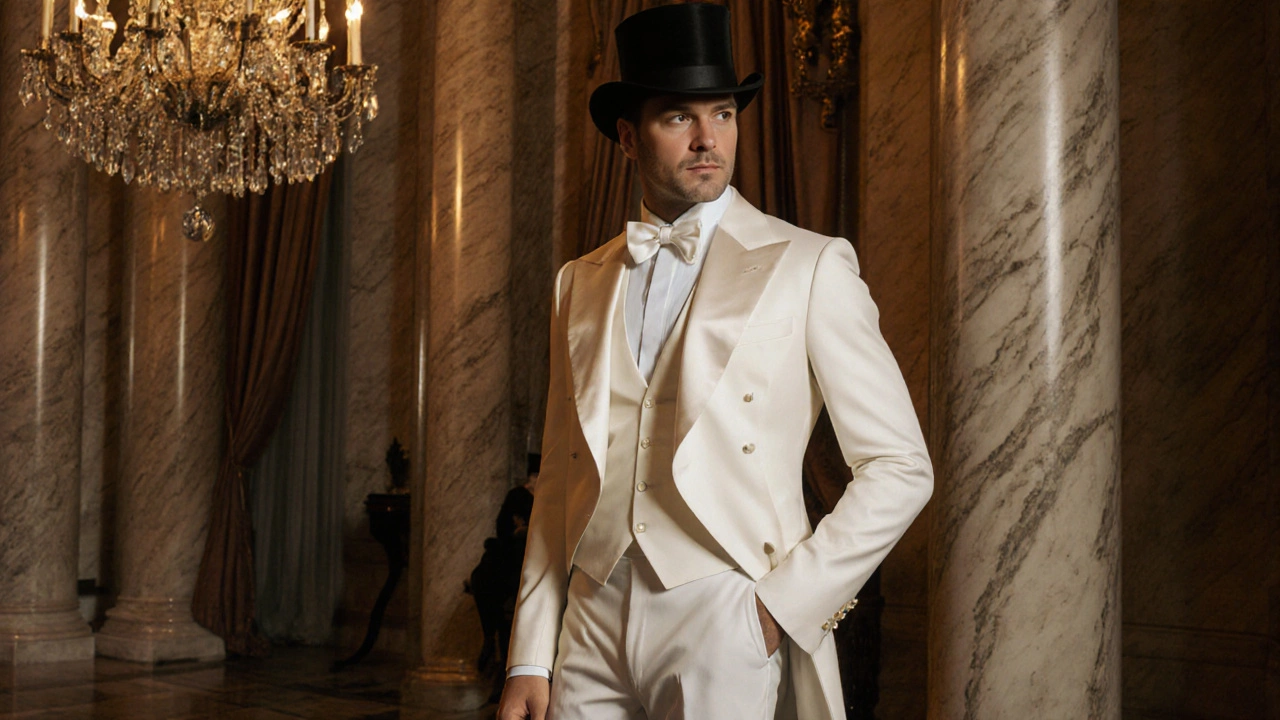Groom Dress Code Selector
Select Your Wedding Details
Quick Take
- Identify the official dress code (white tie, black tie, formal, semi‑formal, or casual).
- Match the code to your venue, season and wedding theme.
- Choose a tuxedo for white‑ or black‑tie, a suit for formal or semi‑formal, and smart‑casual pieces for a relaxed dress code.
- Don’t forget the little details: shoes, boutonnière, pocket square and proper fit.
- Run a final checklist a week before the ceremony.
Groom Dress Code is the set of clothing guidelines that tell a groom what to wear based on the style, venue, time of day and cultural expectations of his wedding. Understanding it saves you from last‑minute panic and makes sure you look sharp alongside your partner.
Getting the groom dress code right is easier than you think once you break it down.
Dress‑Code Levels Explained
White Tie the most formal dress code, usually reserved for state dinners or ultra‑traditional evening weddings. Expect a black tailcoat, silk wing‑collar shirt, white bow tie, low‑cut waistcoat, and black patent leather shoes. Accessories often include cufflinks, a pocket square, and a boutonnière that matches the bride’s bouquet.
Black Tie a classic evening standard that calls for a tuxedo, bow tie and polished shoes. The jacket can be a peak‑lapel, shawl‑lapel or regular notch, but it must have satin or grosgrain lapels. A black formal dress shirt, black bow tie, and a cummerbund or low‑cut waistcoat complete the look.
Formal Attire covers both white‑tie and black‑tie events, but many modern weddings interpret it as a dark suit with a tie. A charcoal or navy suit, crisp white shirt, silk tie, and leather oxford shoes are safe choices. Add a pocket square for a dash of personality.
Semi‑Formal Attire a step down from full formal, suitable for daytime or less strict evening weddings. A two‑piece suit in lighter fabrics (e.g., linen, cotton‑blend) with a patterned tie works well. You can swap the tie for a dress shirt with a subtle pattern if the couple prefers a relaxed vibe.
Casual Attire allows the groom to dress down while still looking put together. Think dress shirts, chinos or tailored trousers, and optional blazers. Sneakers can be acceptable if they’re clean, white leather and the wedding is beach‑side or outdoor.
Choosing the Right Outfit for Your Wedding
The right look depends on three practical factors: venue, season and theme.
- Venue: A cathedral or ballroom typically leans toward black‑tie or formal. A garden, barn or beach often welcomes semi‑formal or casual.
- Season: Winter weddings pair well with heavier fabrics like wool and darker hues. Summer calls for light fabrics-linen, seersucker, pastel colors.
- Theme: A vintage 1920s affair might inspire a tuxedo with a velvet jacket. A boho rustic celebration could let you opt for a linen suit and suede loafers.
Don’t forget cultural traditions. If you have an Indian ceremony, a bandhgala or sherwani replaces the Western suit. For a Scottish wedding, a kilt in the family tartan becomes the centerpiece.

Building the Look: Core Pieces and Accessories
Tuxedo the go‑to garment for black‑tie and white‑tie events should fit perfectly at the shoulders, chest and waist. Have a tailor adjust the sleeve length so that just a quarter‑inch of shirt cuff shows.
Suit the versatile option for formal, semi‑formal and many casual weddings comes in single‑breasted or double‑breasted styles. Choose a lapel that matches the formality: peaked for high‑end, notch for everyday.
Key accessories include:
- Dress shoes - polished black Oxfords for formal, brown brogues for semi‑formal, clean leather sneakers for casual beach weddings.
- Boutonnière - usually a single flower that mirrors the bridal bouquet.
- Pocket square - adds a splash of color; silk for formal, cotton for daytime.
- Watch - a classic analog piece works better than a sport watch for most dress codes.
- Cummerbund vs. vest - cummerbunds are traditional for black‑tie, while a low‑cut vest works for formal or semi‑formal.
Common Mistakes to Avoid
- Mixing fabrics - pairing a velvet jacket with a polyester suit looks cheap.
- Wrong shoe color - black shoes with a navy suit can look mismatched unless you’re going for a bold statement.
- Ignoring fit - an ill‑fitted jacket ruins even the most expensive tuxedo.
- Over‑accessorising - keep it simple; a watch, cufflinks and a boutonnière are enough.
- Skipping the rehearsal - try on the entire outfit with shoes and accessories before the big day.
Checklist for the Groom
- Confirm the official dress code with the couple and wedding planner.
- Select the appropriate garment (tuxedo, suit, or casual ensemble).
- Schedule a fitting at least 8 weeks before the ceremony.
- Choose shoes, belt, and accessories that match the outfit.
- Coordinate color and style with the groomsmen.
- Arrange for dry‑cleaning and final press the week before.
- Pack a travel kit (starch, shoe shine, lint roller) for the wedding day.
Comparison of Common Groom Dress Codes
| Dress Code | Key Outfit | Accessories | Best Settings |
|---|---|---|---|
| White Tie | Tailcoat, white wing‑collar shirt, white bow tie, waistcoat, patent shoes | Cufflinks, pocket square, boutonnière, silk gloves (optional) | State dinners, ultra‑formal evening weddings |
| Black Tie | Tuxedo, black bow tie, cummerbund or waistcoat, dress shirt | Cufflinks, pocket square, boutonnière | Evening weddings in ballrooms or historic venues |
| Formal | Dark suit (charcoal/navy), silk tie, dress shirt | Pocket square, cufflinks, boutonnière | Daytime or early‑evening weddings in upscale locations |
| Semi‑Formal | Two‑piece suit in lighter fabric, patterned tie or dress shirt | Casual pocket square, boutonnière, leather shoes | Garden, barn, rooftop or beach weddings |
| Casual | Dress shirt, chinos or tailored trousers, optional blazer | Casual shoes, minimal accessories, pocket square (optional) | Outdoor, destination or relaxed themed weddings |

Frequently Asked Questions
Do I really need a tuxedo for a black‑tie wedding?
Yes. Black‑tie specifically calls for a tuxedo with a satin lapel, black bow tie and polished dress shoes. A dark suit looks under‑dressed and can draw unwanted attention.
Can I wear a white suit for a summer wedding?
A white or cream suit works for a daytime, beach‑side ceremony as long as the fabric is lightweight (linen or cotton‑blend) and you pair it with a pastel shirt and brown loafers.
What should I do if the wedding has a cultural dress code?
Follow the tradition - a sherwani for an Indian ceremony, a kilt for Scottish heritage, or a hanbok for Korean weddings. You can still match colors to the bridal party for cohesion.
How early should I schedule a fitting?
Aim for a first fitting at least eight weeks before the date, with a final adjustment two weeks out. This timeline leaves room for any tailoring tweaks.
Is it okay to match my suit color with the bridesmaids?
Yes, as long as the shade is a few tones darker or lighter. For example, if bridesmaids wear dusty rose, a navy suit with a rose pocket square creates a harmonious look.
